Self-employed persons’ accidents at work
This section focuses on accidents at work among farmers and other self-employed persons. Self-employed persons’ (excl. farmers) accidents at work were separated in occupational accident statistics from wage and salary earners’ accidents at work for the first time in 1995. Before that self-employed persons’ accidents were included as such in wage and salary earners’ accidents at work. When examining the figures on self-employed persons’ accidents at work it must be borne in mind that accident insurance is voluntary for self-employed persons, and not all of them are insured. Therefore, the distribution of self-employed persons’ accidents at work according to different background variables (age, occupation, industry) also illustrates in which occupations and sectors self-employed persons are more insured than usual.
In Finland, most farmers live on their farms, which makes it impossible to make a distinction between accidents at work and commuting accidents. In this publication all accidents occurring to farmers in their work are called accidents at work. The data on farmers’ accidents at work are based on the information obtained from the Farmers’ Social Insurance Institution (MELA).
Apart from a full-time and working age farmer, the insured can be a pensioner, an under 18-year-old family member or a person practising part-time agriculture, game or reindeer husbandry or fishery. The number of farmers has been falling steadily in recent years. At the end of 2010, there were 78,558 farmers insured by the Farmers’ Social Insurance Institution, which is about 2,600 fewer than one year previously and over 33,000 fewer than in 1999.
Farmers’ risk of death at work diminished slightly
Of all the farmers’ accidents at work for which compensation was paid in 2010 six were fatal, whereas in the previous year four farmers died in consequence of an accident at work. Five male farmers and one female farmer died in an accident at work. Of all the farmers’ fatal accidents at work in 2001–2010 only one occurred to a woman. Figure 10 presents the accident incidence rates of farmers from 2000 to 2010 with regard to deaths at work and accidents leading to disability of at least four days. The figure shows that the risk of death at work varies strongly in different years. In 2010, 7.5 per 100,000 insured farmers died, while in 2009 the corresponding ratio was 4.8. In 2008, the ratio was 8.2 and in 2007 it was 9.2. The year 2000 was the darkest in the near past; a total of 12.9 per 100,000 insured farmers died in accidents at work.
Figure 10. Farmers’ accident rates in 2000–2010
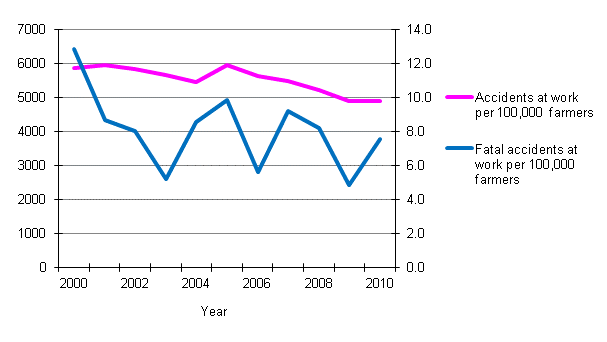
An examination of the time series reveals that farmers’ risk of fatal accidents at work has fallen by good one-tenth (12%) during the 2000 to 2010 period. This becomes clear if we compare two five-year periods with each other. In the 2001 to 2005 period, farmers had 39 fatal accidents at work, which is an average of 8.0 per 100,000 farmers per year. In the 2006 to 2010 period, a total of 30 farmers died accidents at work, which converts to an annual average of 7.1 fatal accidents per 100,000 farmers.
Table 13 compares the incidence rate of accidents leading to the death of the farmer with the riskiest industries among wage and salary earners in 2010. Because the majority of persons who die as a result of an accident at work are generally men, their accident incidence rates are given separately. The figures indicate that male farmers’ work was the most dangerous. Of them, a total of 9.4 per 100,000 insured farmers died in accidents at work in 2010. In 2009, the corresponding figure was 5.5.
In 2010, the riskiest industry for wage and salary earners was transportation and storage. In this industry the risk of death at work was 4.6 (for men 5.9) per 100,000 insured wage and salary earners. The second most risky industry for wage and salary earners was construction. In this industry the risk of death at work was 4.6 (for men 5.1) per 100,000 insured wage and salary earners.
Table 13. Farmer’s fatal accidents at work compared with wage and salary earner’s fatal accidents in high risk industries per 100,000 farmers or wage and salary earners in 2009–2010 1)
| 2008 | 2009 | |||
| Total | Males | Total | Males | |
| Farmers | 4,8 | 5,5 | 7,5 | 9,4 |
| Wage and salary earners | 1,2 | 2,1 | 1,6 | 3,0 |
| Manufacturing | 0,3 | 0,4 | 2,3 | 3,2 |
| Construction | 4,5 | 5,0 | 4,6 | 5,1 |
| Transportation and storage | 4,7 | 4,1 | 4,6 | 5,9 |
Farmers’ accidents at work decreased
The changes in the numbers of farmers are also visible in the numbers of accidents at work. In 2010, MELA paid compensation for 4,555 occupational accidents of farmers. The figure is around 180 cases lower than in the previous year. There were a total of 3,898 occupational accidents leading to disability of at least four days, while in the previous year the respective figure was 4,045 (-3.6%). The number of farmers’ accidents at work has been falling during the past ten years, the year 2005 excluded (Figure 11). The accident peak in 2005 could in part be the result of the introduction of the full-cost responsibility system of patient care that year.
Figure 11. Farmers’ non-fatal accidents at work resulting in at least 4 days’ absence in 2000–2010
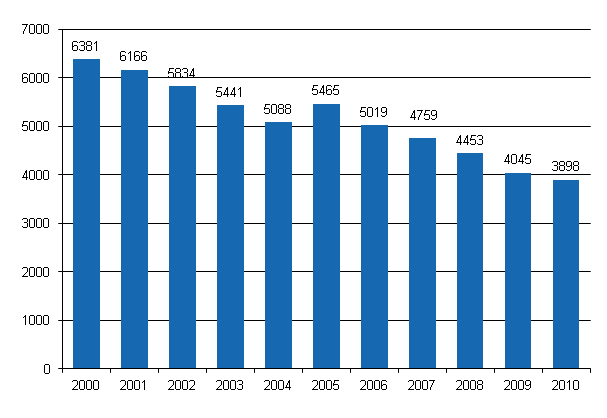
Among farmers, the proportion of minor accidents at work resulting in disability of less than four days has stayed roughly unchanged in recent years at around 15 per cent of all compensated accidents. Nearly every third (32.0%) accident at work was a so-called serious accident, i.e. caused disability lasting longer than one month. In the following, the focus will be on those accidents at work that resulted in absence of at least four days from work.
Farmers’ risk of accidents increases with age
In 2010, there were 4,882 accidents at work per 100,000 insured farmers, which is almost as many (-0.3%) as in 2009 (4,897). However, farmers’ risk of accidents is still clearly higher than that of wage and salary earners and distinctly higher for men than for women: men had 5,605 and women 3,443 accidents at work per 100,000 insured farmers (Figure 12). The difference between the genders is partly explained by the fact that in farming men conventionally do the kind of work in which accidents are common. Such work includes e.g. construction work and tasks related to the use and maintenance of machinery and equipment.
Figure 12. Farmers’ accident at work per 100,000 insured by gender and age in 2010
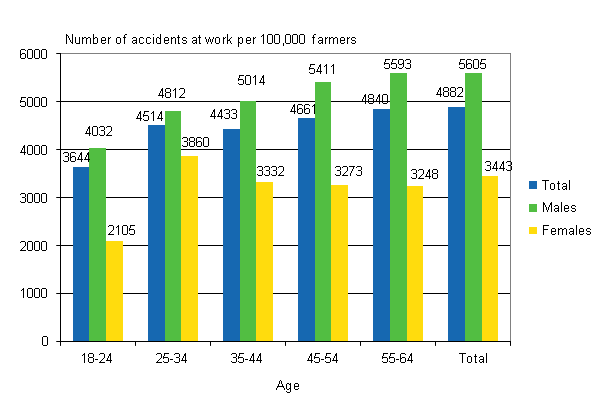
More than six out of ten (63.2%) of farmers’ accidents occur to those aged 45 or over. In 2010, the relative number of accidents was highest among those aged 55 or over: 4,840 per 100,000 farmers. The corresponding ratio for persons aged under 25 was 3,644 in 2010. In 2009, the same ratio for persons aged under 25 was 4,035 and in 2008 it was 3,694. The annual variation in their accident risk can be quite large, as there are not many insured farmers in the youngest age group.
Most accidents occur in animal husbandry
The proportion of accidents occurring in various animal husbandry tasks was about the same as one year previously, or good four in ten (45,9%) of all accidents at work (Table 14). Especially women fell victims to accidents at work when tending cattle; more than four out of five (79.3%) of women’s accidents at work took place in animal husbandry. Among men, the respective proportion was good one-third (35.6%). The second highest number (24.3%) of accidents occurred in other agricultural and forestry work, including tasks such as installation and maintenance of machinery and equipment. Approximately one accident in six (13.3%) occurred while performing other tasks related to farming. However, no actual conclusions can be drawn from the available statistical data about the dangerousness of work in different areas, because then the number of working hours spent on different tasks should also be known. The classification of the variables describing the stage of work is national. The classification used by MELA is more detailed than the ESAW variable illustrating the working process (cf. Table 2).
Table 14. Farmers’ accidents at work by type of work and gender in 2010
| Total | Males | Females | ||||
| N | % | N | % | N | % | |
| Total | 3 898 | 100 | 2 978 | 100 | 920 | 100 |
| Farming work | 517 | 13,3 | 461 | 15,5 | 56 | 6,1 |
| Animal husbandry | 1 789 | 45,9 | 1 059 | 35,6 | 730 | 79,3 |
| Forest work | 324 | 8,3 | 300 | 10,1 | 24 | 2,6 |
| Construction work | 188 | 4,8 | 175 | 5,9 | 13 | 1,4 |
| Other agricultural and forestry work | 948 | 24,3 | 859 | 28,8 | 89 | 9,7 |
| Other work | 132 | 3,4 | 124 | 4,2 | 8 | 0,9 |
Farmers most often injured as a consequence of horizontal or vertical impact with or against a stationary object
Horizontal or vertical impact with or against a stationary object was the most common mode of injury for farmers. In three out of ten (32%) cases the person was injured due to horizontal or vertical impact with or against the floor, ground or the like (Figure 13). Women farmers were pushed or kicked by an animal more often than men, as every fourth (26%) of women farmers’ accidents was caused by an animal. Every tenth (11%) man injured in an accident was hurt by an animal bite, kick or the like.
The Farmers’ Social Insurance Institution collects data on the material agent, type of injury and injured body part using the ESAW classification.
Figure 13. Farmers’ accidents at work by contact-mode of injury and gender in 2010
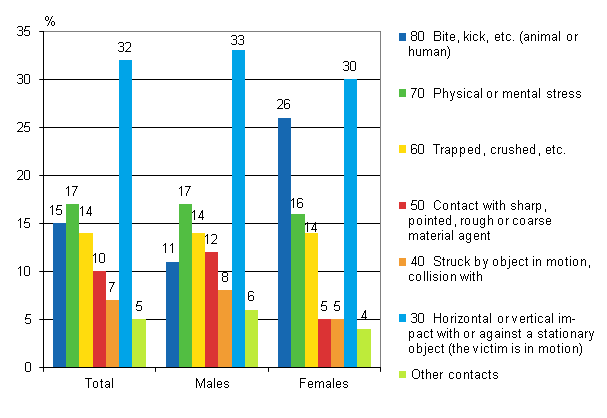
In around one-quarter (27.6%) of farmers’ accidents at work the material agent was an animal or a human being, or the injury was caused by a plant (Figure 14). In all probability most of these farmers’ accidents were expressly caused by animals. Various buildings, structures and surfaces were the material agents in every fifth accident (20.0%). Physical phenomena and natural elements caused 10 per cent of the accidents at work.
Figure 14. Farmer’s accidents by material agent of contact-mode of injury in 2010
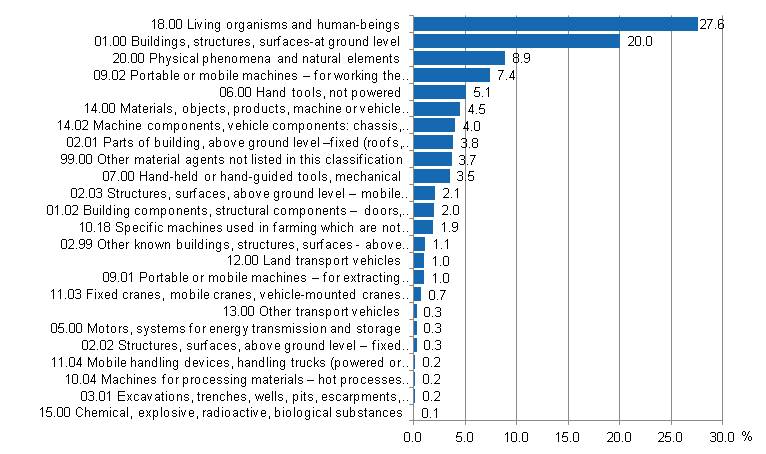
In 2010, a total of 37 per cent of farmers’ injuries sustained in accidents at work were diverse dislocations, sprains and strains. Wounds and superficial injuries form another large group of injuries (33%). Seventeen per cent of all injuries to farmers were bone fractures. There were no significant differences in the distributions of men’s and women’s injuries: men’s injuries were more often wounds and superficial injuries, while women’s injuries were different kinds of sprains and strains (Figure 15).
Figure 15. Farmers’ accidents at work by type of injury and gender in 2010

About seven out of ten (73%) of all the accidents at work which occurred to farmers concerned extremities (Figure 16). Women injured their lower extremities more often than men did. Injuries to lower extremities most often involved knees and those to upper extremities palms or fingers.
Figure 16. Farmers’ accidents at work by injured body part and gender in 2010
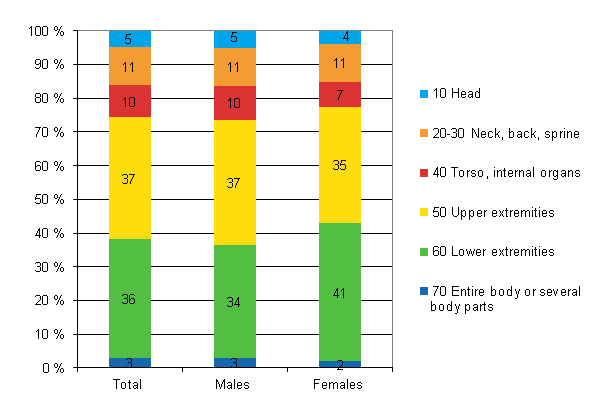
Self-employed persons most often injured in manufacturing occupations and building construction
In 2010, insurance companies paid self-employed persons compensation for a total of 5,887 accidents at work. This also includes accidents on which compensation was paid only for medical treatment expenses. The proportion of these accidents at work that led to absence from work for less than four days was over 40 per cent in all self-employed persons’ accidents. One year previously compensation was paid for 5,694 accidents. These data concern self-employed persons other than farmers.
In 2010, self-employed persons had 3,292 accidents at work that led to disability of at least four days. This is 35 cases fewer than in the previous year. The gender distribution of accidents at work is the same among self-employed persons as among wage and salary earners: the vast majority (84%) of the accidents of self-employed persons occurred to men. The age distribution of victims of accidents at work shows that around two-thirds (61%) of self-employed persons’ accidents occurred to persons aged 35 to 54 (Table 15).
Table 15. Self-employed persons’ accidents at work by gender and age in 2010
| Age | Total | Males | Females | |||
| N | % | N | % | N | % | |
| Total | 3 292 | 100 | 2 750 | 100 | 542 | 100 |
| 15–24 | 41 | 1,2 | 34 | 1,2 | 7 | 1,3 |
| 25–34 | 425 | 12,9 | 361 | 13,1 | 64 | 11,8 |
| 35–44 | 853 | 25,9 | 735 | 26,7 | 118 | 21,8 |
| 45–54 | 1 148 | 34,9 | 948 | 34,5 | 200 | 36,9 |
| 55–64 | 750 | 22,8 | 619 | 22,5 | 131 | 24,2 |
| Others | 75 | 2,3 | 53 | 1,9 | 22 | 4,1 |
Similarly to wage and salary earners, self-employed persons also had the highest numbers of accidents at work in manufacturing occupations and building construction. Examined by industry, self-employer persons’ risk industries are also mostly the same as those of wage and salary earners. The most dangerous industries are construction, and transportation and storage.
Source: Occupational accident statistics 2010, Statistics Finland
Inquiries: Tarja Seppänen 09 1734 3220, tyotapaturmat@stat.fi
Director in charge: Riitta Harala
Updated 30.11.2012
Official Statistics of Finland (OSF):
Occupational accident statistics [e-publication].
ISSN=1797-9544. 2010,
Self-employed persons’ accidents at work
. Helsinki: Statistics Finland [referred: 25.4.2024].
Access method: http://www.stat.fi/til/ttap/2010/ttap_2010_2012-11-30_kat_002_en.html

